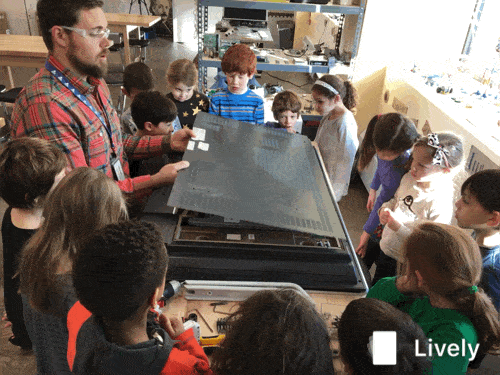Tinker Lab Take-Apart and Circuits Galore!
Curious to see what’s happening in our Tinker Labs?
Early Childhood Campus
The world of electricity and circuits is all about making connections; literally and figuratively. Squishy Circuits are an excellent avenue for our youngest learners to do just that. Just the appearance of the conductive dough is familiar for most everyone because it looks just like Playdough. And for all intents and purposes, it is. The difference is an additive that turns the dough into a conductive material. Here are the recipes, if you’re curious. With that in mind, our children wasted no time getting their hands on the dough and shaping into spheres so they could poke the tails of the battery packs, LEDs, and motors into the dough.
The comparisons between Squishy Circuits and Snap Circuits are very straight forward: both have battery packs, wires, lights, and motors. They differ in their ability to control the flow of electricity based on the shape and structure of the circuit and connections. The freedom and playfulness of the conductive dough is a fun shift in thinking about the possibilities of electricity and circuits. Have a look at the video below. This is a group of 4 and 5 year olds working on Snap Circuits.
Flagship Campus
The world of electronics is complex, ever-changing, and enormous. When we put out a call to our families for old electronics to take apart, I wasn’t quite sure what would come in. A couple months later, the donations continue to trickle in…one old phone, DVD player, computer, TV or something else, at a time. We can’t say THANK YOU enough to our families for their generosity in donations and encouragement to take things apart in the name of discovery and learning! The number of circuit boards being discovered in the electronics as we disassemble them is fascinating.

In addition to the take-apart work, this group of students have also been introduced to Snap Circuits. Most recently, all Flagship Campus students built a circuit called “Conduction Detector” and it’s made to test objects to find out if they are conductive or not. This activity was a huge success for children as they were given the freedom to wander the TinkerLab and test just about any object they could find. The idea of metal being the conductive material in objects quickly came to the front of many children’s minds. Finding metal in various objects was a whole other task.
In an attempt at sharing more about our experiences in the TinkerLab, here is a time lapse video of full on “work time” with Snap Circuits. Draw your attention to the sense of focus and collaboration throughout the 45 minutes class periods. Kits are handed to pairs of students and then they are encouraged to work through a project list. There are 101 projects and many require modifying a base circuit by just a piece or two. All projects have a clearly written “objective” and many include lights, sounds, and motor action. We encourage children to tinker with their circuits to try their own combination of pieces, based on what they’ve learned or something they might be curious about. Part of the beauty of the Snap Circuits kits is that they are built with safety and simplicity of connection in mind. You will also notice the classroom has a clear sense of structure that involves the students commanding materials and moving about the lab for other tools of items they might need.
Would you like to take a spin around our Tinker Lab with Mr. Reynolds? Join us on March 4, 2017 at 9:30 for Circuits R Us. This event is designed for students that will be 5 years of age by September 1, 2017. Click here to save your spot!